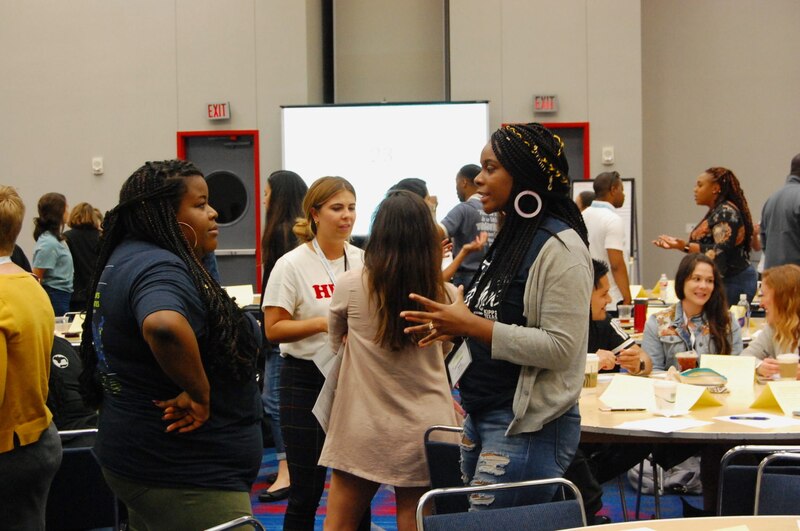HOUSTON — A lot has changed in the seven years since teacher Nadia Abdalah helped to open a KIPP charter school in Austin, Texas.
Back then, her elementary school employed a staff of 18 and teachers spent a big chunk of their time developing lesson plans with little support. Today, her school’s staff is about three times the size. Teachers can turn to specialists across the charter network for curriculum help. And Abdalah even got a budget this year for her team of second-grade teachers to spruce up their classrooms with lamps and cushions for students to read on — an expense other teachers often pay for out of pocket.
“We very seldom ask for something that’s for the kids that’s not provided for us,” Abdalah said. “There’s power in numbers.”
Abdalah is not the only one to take note of the benefits that have come with KIPP’s growth, as it’s transformed over the last 25 years from a single middle school into the largest nonprofit charter school network in the country.
As of this summer, network officials say, KIPP will educate more than 100,000 students in 242 schools across 20 states and Washington, D.C. And KIPP is still growing, thanks in large part to many years of federal support. Just this year, KIPP won an $88 million federal grant to open or expand dozens more schools over the next five years.
The scale of that growth was on display at the charter network’s annual summit this week, where some 6,000 educators and alumni gathered in Houston to attend trainings and celebrate the charter network’s 25th anniversary.
Some elements were new: KIPP aimed a portion of the event at adult alumni, offering help with things like money management and mental health, and officials said more formal efforts to connect alumni are in the works. (It was also the first national summit since KIPP fired one of its co-founders, Mike Feinberg, following an investigation into allegations of past sexual misconduct with a student and two alumni.)
Other aspects, including a full day devoted to race and equity, reflected discussions that have been going on for years within KIPP about the right kinds of student discipline to employ, the shrinking but still sizable racial divide between its students and staff, and whether schools should relax their laser-like focus on college for all.
Speaking to the thousands of attendees, KIPP Foundation CEO Richard Barth said he had been listening, and recognized the ongoing tensions.
KIPP’s goal now, he said, was to create schools that are both “joyful” and “academically excellent” and to prepare students for whatever paths they may take, whether that be college or something else.
“The foundation of all of this work rests on a commitment to equity and racial justice,” Barth told the audience. That, he added, meant taking stock of his own identity as the white, male head of a charter network that serves nearly all black and Hispanic students. “It’s my job to become ever more aware of the biases I bring and to also disrupt inequities wherever I see them.”
The ongoing discipline evolution
KIPP was among several charter networks to pioneer a “no excuses” approach to student discipline. That philosophy emphasizes classroom order and obedience in a bid to minimize distraction and raise students’ academic achievement — and has been heavily criticized for largely being meted out to students of color by white educators. Over the last decade, KIPP has walked back some of its earlier practices, notably a punishment known as “the bench,” where students were made to sit apart from their peers, sometimes wear a different colored T-shirt, and remain silent outside official class time.
“There are practices that we did in the beginning that we out-and-out abhor,” Barth told Chalkbeat in an interview. “There were mistakes.” The charter network is still focused on providing “safe and structured environments,” he added, but “that’s very different than processes that shame kids.”
Some of that push has come from KIPP’s increasingly diverse staff. The network says that last year, 57% of its teachers were black or Hispanic. In recent years, the charter network has used its annual event to talk more explicitly about race, discipline, and social justice — often tapping KIPP administrators and alumni of color to lead those conversations.
At KIPP’s summit this week, for example, a panel of black alumnae gathered to discuss how they’d navigated both racism and sexism. One alumna, Roquel Crutcher, shared a story about how a white teacher at her KIPP school told her she was her favorite student because she was so quiet and well-behaved. Crutcher said she was struggling personally at the time, but the white teacher never asked her about her life — while black teachers at KIPP had.
“I don’t remember once feeling like I could bring my blackness into that class,” she said.
In another session, dozens of KIPP educators met to talk about race and student discipline. After they had time to reflect on their own experience with school discipline as a child, one of the facilitators, Aundrey Page, a KIPP principal in the Bay Area, asked everyone in the room to think about what “legacy” discipline policies their schools still employed.
He asked them to raise their hands if their school still suspended students — nearly all did. Then if their school still expelled students. Fewer, but still many, raised their hands. Finally, he asked if their schools made students sit in silence as a punishment. Again, many raised their hands.
“[I] really want to push on thinking about what our practices are, what our handbook says, and how that polices our children,” Page said.
KIPP officials say many of their schools now take a more restorative approach to student discipline, but they’re letting individual schools decide how to make changes, if at all. That means it’s happening more slowly in some places, especially in regions with fewer schools.

The next big push: Helping alumni, even after college
As part of a new effort, KIPP is stepping up its work with alumni. The goal is to connect them across state lines, get more alumni into KIPP leadership roles and harness their potential political power.
Nancy Kyei, an alumna of a KIPP school in Baltimore, is part of the two-person team that’s spearheading those alumni efforts. She said in the future, she could see KIPP alumni rallying around causes that affect them, such as immigration reform or funding for charter schools.
“That’s having alumni on the Hill advocating for appropriations, having alumni on social media advocating in their own communities, at their own schools,” Kyei said.
Alumni at the event said they hoped this work would eventually mean they’d have a built-in social network if they moved to a new city, or needed advice about breaking into a field or getting hired at a specific company. It’s the kind of resource many colleges and private high schools offer.
“We want to make sure we accelerate the building of their social capital,” Barth said. “For people of privilege that’s a natural act, but for so many of our alums, they can graduate, have done everything right, but still not know exactly how to advance their interests.”
Network officials set a goal of having 1,000 KIPP alumni in positions of power by 2040. The charter network also launched a drive to register KIPP alumni to vote.
At the summit, alumni could attend several sessions on finances and mental health — topics officials said alumni had requested. The covered skills ranged from investing in stocks to managing a budget to starting a side business. There was a competition where alumni could pitch a business idea and win a cash prize. And there was a larger session with a psychologist who talked about the challenges of navigating academic and professional situations as a person of color.
KIPP officials see this as an extension of their work to guide KIPP students to colleges that are a good fit for them academically, as well as financially and socially — and to help them once they’re there with counseling and, sometimes, emergency cash. KIPP’s research has suggested that this kind of support makes students more likely to graduate from college.
A few years ago, KIPP also launched an “accelerator” program that offers free one-on-one executive coaching to alumni for 10 months.
Jennefer Canales-Pelaez graduated from a KIPP school in Houston and is now an immigration lawyer. She said she used her phone calls and video chats with her coach to work through emotions she’d buried over the last few years as President Trump has stepped up his anti-immigrant policies and rhetoric. They’ve been especially upsetting to Canales-Pelaez, whose father was deported when she was 11.
“I finally realized how angry and upset I actually really was, so I was able to start working through that,” she said. “My coach, she taught me how to just be very reflective and very much recognize patterns of behavior.”
Next up: New cities and the suburbs
KIPP’s plans for growth could face political headwinds. Poll data released earlier this year shows that support for charter schools has fallen dramatically among white Democrats, though it held steady among black and Hispanic Democrats. A few Democratic candidates for president have also said they’d like to end or scale back federal support for charter school growth.
Barth says the network is going to “work like heck” to make sure KIPP receives all of the federal money it was promised this year. But he also sees the current pushback as part of a natural cycle.
“We had a 20-year period where the political stars were lined up to support us,” he said. “My belief is that over the next five to 10 years, some of that noise goes away. The resistance to this from the outside, nationally, won’t override local support and local demand.”
Using that federal money, KIPP plans to expand or open 52 schools, mostly in cities in and around where the charter network already operates. For example, KIPP is looking to open schools in Stockton, California and in Baton Rouge, Louisiana, not far from where KIPP already runs schools in the Bay Area and New Orleans.
“In so many communities — Austin, Atlanta, Nashville, obviously California, D.C. — many of the places where 10 to 20 years ago I’d say, this is where the need is, have gentrified,” Barth said. “And many of our families are being pushed out of the city limits.”
Moving into more suburban districts could present other political challenges, as those districts and their school boards may be less familiar with and less friendly to charter schools. When KIPP tried to open a school outside Denver last year, for example, the effort failed to get the school board’s support. But Barth said he’s confident the demand is there and says the network will continue to experiment, including by paying attention to models like the racially integrated middle school it plans to open in a part of New York City that includes the Upper West Side and Harlem.
“I think there’s room for that,” he said. “I view that as a leader in the network, showing how it could be done.”


